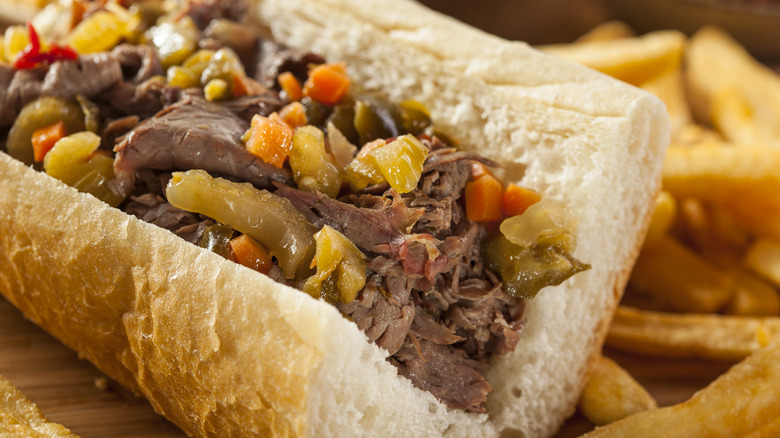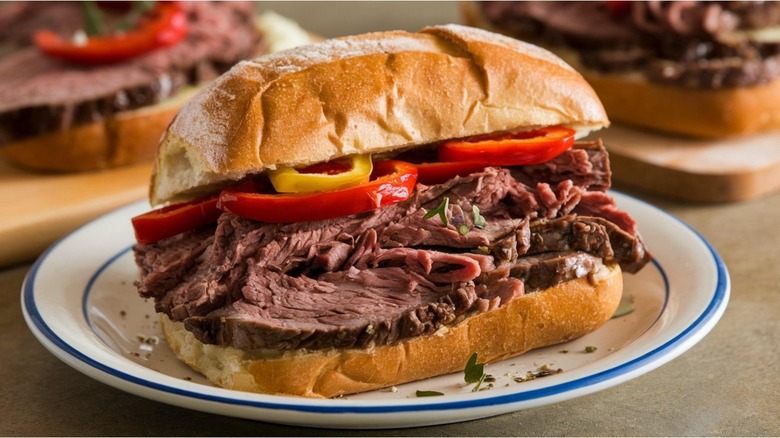What Makes Italian Beef Sandwiches A Step Above The Rest?
The Italian beef sandwich was delicious long before "The Bear" made it trendy, but its appearance on the Emmy-winning show has vaulted it into the city's food lexicon alongside iconic Chicago dogs, deep dish pizza, and tavern-style pizza. So what makes this beef sandwich so iconic?
The answer is that the sandwich is greater than the sum of its parts. Created by Italian immigrants striving to stretch their budgets and pantries as far as possible in the 1920s and '30s, the beef is similar to barbecue in that it was created out of practicality rather than decadence. There are various stories about its origin — with Al's #1 Italian Beef claiming to be the inventor — but all you need to do is try it, specifically in its birthplace, to understand why Chicagoans gravitate toward the gravy.
You start with a French roll capable of soaking up jus without disintegrating, especially if you go for it dipped, which is exactly what it sounds like — they dunk the entire sandwich before serving it, creating gravy bread. The meat must be simmered in jus and shaved, not sliced, or else you risk a tough bite. Whether you top it with spicy giardiniera, sweet peppers, or both, is a matter of personal preference.
So the answer isn't just the ingredients, or the resourceful people who made it, or the iconic city that's sustained it, but all of the above. In the same way that New York pizza and bagels taste better in New York, Italian beefs taste better at a table inside a Chicago eatery with a mound of napkins close at hand and a side of fries.
What's the best way to order an Italian beef?
There are a variety of approaches, many of which are acceptable, but you must first know the rules of ordering a beef to know why you're breaking them. If you don't like spice, go with sweet peppers as your topping of choice. However, you should try it with giardiniera at least once. Yes, the mixture of pickled cauliflower, carrots, peppers, celery, and whatever else the purveyors add to theirs doesn't feel like a stereotypical garnish, yet live in Chicago long enough, and you'll put it on everything.
Another key is you don't want to order one to-go, or god forbid, have it delivered, because there's a timestamp on this sandwich, and the pleasurability decreases every second it goes untouched. While you can order it certain ways to stave off the expiration date — not dipped, or with cheese for a barrier between bread and meat — a dry beef is a roast beef sandwich, and cheese pushes it more toward a French dip or a Philly cheesesteak. Remember, the meat is cooked in gravy and isn't strained, so regardless of how you take it, the bread is going to get soggy.
It's also okay to pile on both sweet peppers and giardiniera, and eat with your elbows on the table, hands hanging loosely over the sheets of wax paper and foil. Don't touch anything but your beverage, your fries, your sandwich, or napkins lest you risk juices showing up on the straps of your backpack or purse. Again, if you want cheese, that's fine, just don't be surprised if someone docks one of the stars off your Chicago flag paraphernalia.
How to identify a quality Italian beef in Chicago
The best way to find a solid Italian Beef in Chicago isn't on Instagram, or a preselected, internet-approved choice, but rather to follow the locals. There are any number of restaurants that offer them, and there's likely a spot closer to your hotel than taking the Brown line down to the Chicago and Franklin stop for a selfie in front of Mr. Beef, the iconic restaurant where the first season of "The Bear" was shot.
Now, if the sandwich arrives and the meat is sliced instead of shaved, or you catch your server slopping beef onto a hotdog bun — those aren't good signs. General vibes matter, too. Organized chaos is different from dysfunction. The clerk taking your order should speak in a vernacular accustomed to the sandwich and not flinch when you say "hot," "sweet," or "dipped."
If you walk in and see signed, faded photos of local celebrities and sports figures, along with a crowd of blue-collar workers, covered in a thin film of sweat, casually swearing about the Cubs or White Sox while inhaling the Chicago staple, you can be fairly confident that the beef is on point. However, if the place is empty, overly clean, and the atmosphere feels manufactured, it's likely that the product is missing that certain joie de vivre necessary for a memorable and enjoyable Italian beef in Chicago.



